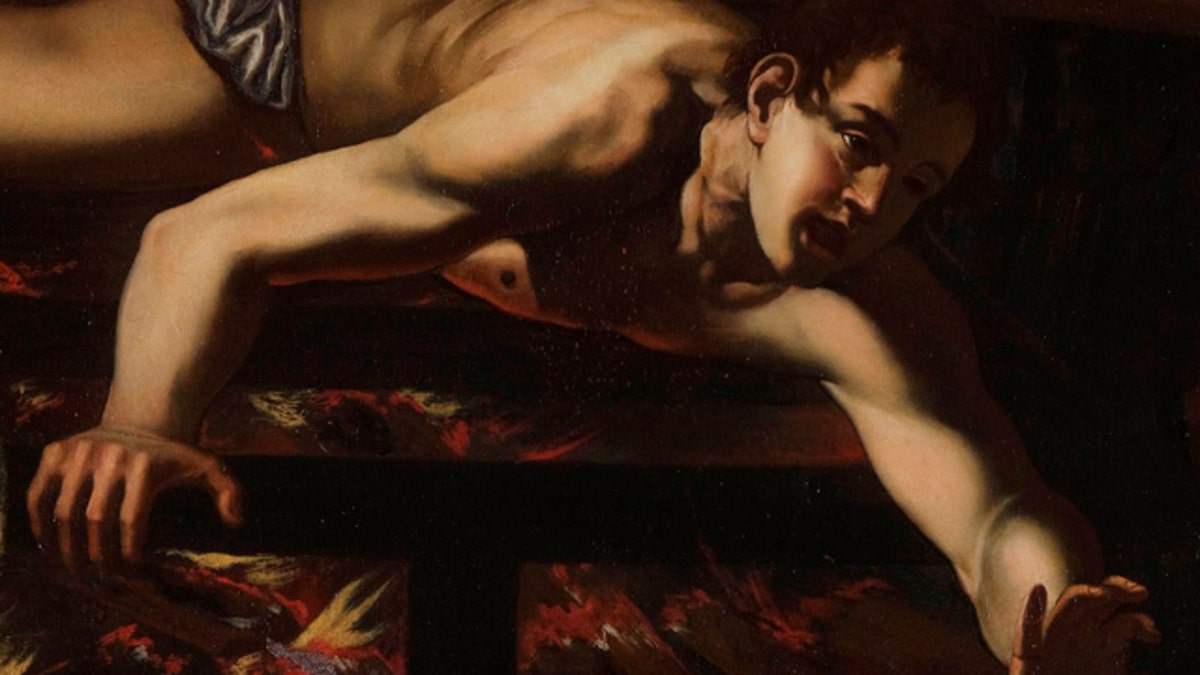
Undated picture made available by the Vatican newspaper L'Osservatore Romano showing a painting depicting "The Martyrdom of St. Lawrence". The Osservetore Romano reported Saturday, July 17, 2010 that it could be a new Caravaggio painting, but cautioned that further analyses are required to ascertain whether the canvas is indeed the work of the Italian master. The story, on the the front-page of L'Osservatore Romano, came out as Italy celebrates the 400th anniversary of Caravaggio's death. The painting depicting "The Martyrdom of St. Lawrence" belongs to the Jesuits in Rome, the paper said. It did not say where the painting is being studied or who's examining it. (AP Photo/L'Osservatore Romano, HO, Zelo Colantoni)
ROME – ROME (AP) — It seemed too good to be true: The discovery of a new painting by Caravaggio during the celebrations marking the 400th anniversary of his death. It turns out, it probably was.
Scholars unveiling the painting Tuesday concurred that the "Martyrdom of St. Lawrence" did not look like a Caravaggio, but rather like the work of one or more of his followers. This week, the Vatican newspaper, which first suggested the canvas could be the work of Caravaggio, shot down its own report and retracted the claim.
The painting will still be subjected to X-ray tests and other analyses to ascertain its attribution. But experts held out little hope that a new work by the Italian master has been found.
"It's a very interesting painting but I believe we can rule out — at least for now — that it's a Caravaggio," said Italy's art superintendent Rossella Vodret, moments before unveiling the painting in the Jesuit church where it has been kept for years.
"There are certain elements that are disconcertingly poor," she added. "The quality of the painting doesn't hold up."
The 183-by-130.5 centimeter (72-by-51 inch) oil on canvas is dominated by the figure of St. Lawrence being grilled to death, his three executioners in the background. The painting features the dramatic chiaroscuro typical of Caravaggio and his school.
The Vatican newspaper L'Osservatore Romano set the art world aflutter last week with a front-page article headlined "A New Caravaggio."
The article made clear that no certain attribution had been made and that further tests were required. But the definitive-sounding headline and the fact that the claim was made on the day marking the 400th anniversary of the master's death had raised expectations. The Vatican has in the past announced such art-world news in L'Osservatore, sometimes coinciding with an anniversary.
The claim apparently took even the Jesuits by surprise. "We've walked past it hundreds of times, paying no attention," said the Rev. Daniele Libanori, rector of the Chiesa del Gesu in Rome. He said the painting was hung in a private room until a cleanup this year showed a work interesting enough to call in art experts.
On Monday, the Vatican newspaper reversed itself and published an article by the Vatican's top art historian shooting down the claim. Under the headline "A New Caravaggio? Not really," Vatican Museums chief Antonio Paolucci wrote that the work was not of Caravaggio's quality and termed it "modest" at best.
Tests will make the final call.
The "Martyrdom of St. Lawrence" will be examined for a few months beginning in September, including with X-rays and analyses on the layers of paint and the materials that were used. Archive research will try to trace the history of the painting and who commissioned it.
Scholars said the painting is uneven artistically, with some beautiful elements and some parts they didn't hesitate to call "very poor" and even "embarrassing." This suggested that two different people may have worked at it, though it is not certain.
Vodret said the most interesting element of the work was the position and perspective of the saint, who is shown on the grill, one arm extended, his figure lit up. Such unique iconography might have suggested the hand of Caravaggio, known for showing scenes as if shot from unusual angles.
She said the hand of one of the executioners, holding a stick to keep the saint down, is also of good quality. But she and the other experts noted that other elements were poor, such as the bodies of the executioners, the cloth covering Lawrence, and one of the saint's legs, which appears to be awkwardly attached to his torso.
"The leg looks like a frog's leg. Caravaggio would never have made such a mistake," said Marco Bona Castellotti, an art historian. Even as he saw the painting for the first time at Tuesday's unveiling, he had no doubt it couldn't be Caravaggio.
Experts believed the work may have been done by a follower, likely in Naples, Sicily or Malta — all places where the painter spent time during his tumultuous life. Caravaggio died in a Tuscan coast town in 1610 in mysterious circumstances, and a group of Italian researchers said recently that they had identified his long-lost remains.
Silvano Vinceti, who led the research and recently co-wrote a book called "The Caravaggio Mystery," noted that since Caravaggio did not sign his works — save one known exception — attempts at fakes and uncertain claims of authenticity have been frequent.
"The paradox is that there are attributions that don't hold up, and then probably there are paintings by Caravaggio that we know nothing about," he said.
